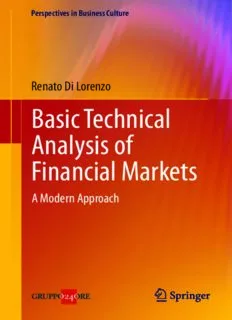
Basic Technical Analysis of Financial Markets: A Modern Approach PDF
Preview Basic Technical Analysis of Financial Markets: A Modern Approach
Perspectives in Business Culture Renato Di Lorenzo Basic Technical Analysis of Financial Markets A Modern Approach Perspectives in Business Culture For further volumes: http://www.springer.com/series/10441 Renato Di Lorenzo Basic Technical Analysis of Financial Markets A Modern Approach 1 3 Renato Di Lorenzo Genova Italy ISSN 2280-1464 ISSN 2280-2088 (electronic) ISBN 978-88-470-5420-2 ISBN 978-88-470-5421-9 (eBook) DOI 10.1007/978-88-470-5421-9 Springer Milan Heidelberg New York Dordrecht London Library of Congress Control Number: 2013934986 Translation from the Italian language edition: La guida del Sole 24 ORE all'analisi tecnica by Renato Di Lorenzo, © Il Sole 24 ORE 2013. © Springer-Verlag Italia 2013 This work is subject to copyright. All rights are reserved by the Publisher, whether the whole or part of the material is concerned, specifically the rights of translation, reprinting, reuse of illustrations, recitation, broadcasting, reproduction on microfilms or in any other physical way, and transmission or information storage and retrieval, electronic adaptation, computer software, or by similar or dissimilar methodology now known or hereafter developed. Exempted from this legal reservation are brief excerpts in connection with reviews or scholarly analysis or material supplied specifically for the purpose of being entered and executed on a computer system, for exclusive use by the purchaser of the work. Duplication of this publication or parts thereof is permitted only under the provisions of the Copyright Law of the Publisher’s location, in its current version, and permission for use must always be obtained from Springer. Permissions for use may be obtained through Rights Link at the Copyright Clearance Center. Violations are liable to prosecution under the respective Copyright Law. The use of general descriptive names, registered names, trademarks, service marks, etc. in this publication does not imply, even in the absence of a specific statement, that such names are exempt from the relevant protective laws and regulations and therefore free for general use. While the advice and information in this book are believed to be true and accurate at the date of publication, neither the authors nor the editors nor the publisher can accept any legal responsibility for any errors or omissions that may be made. The publisher makes no warranty, express or implied, with respect to the material contained herein. Printed on acid-free paper Springer is part of Springer Science+Business Media (www.springer.com) to Annie Preface Those who practice correctly technical analysis—after having studied it seri- ously and having had the patience to understand it fully—having established its effectiveness cannot but be surprised at how many investors lose regularly on the markets. Usually this happens because most of them do not analyze things as they are (i.e., as they appear from the graphs of the price and, maybe, the volumes) but as they should be, paying attention to economists, TV commentators, magazines, blogs, and all the folklore—often with a personal interest in what they are saying— that revolves around this colorful world. The classic books on Technical Analysis—on the other hand, it must be admitted— are now hopelessly aged. The analysis techniques have changed, people have learned, they have evolved: what was hard to do years ago, today with the free tools available on the Internet have become quite simple, and this has also relentlessly emphasized that a number of classical teachings have revealed to be pure fantasy, or that they are too simple to be really useful. A more efficient technical analysis is needed, then, one that is not satisfied with protocols that just seem to be fine, but which requires that they are fine, verifying it through simulations on the PC, serious statistical counts, and so on. Those above are the reasons for the exclusion from this book of popular chapters, even fascinating ones, such as the Elliot Wave theory or the Gann Fans, because those recipes are not well statistically veriafi ble. Good reading, then, and my usual good luck! Renato Di Lorenzo vii Acknowledgments The author thanks Stefano Caroti Ghelli for his help. Many graphs are constructed by use of the site www.ProRealTime.it; the author thinks it is one of the best sites for technical analysis on the Internet. Special thanks to Gabriele Bonetti and Marina Forlizzi. ix Warnings The worksheets and the codes used in this book will be sent free of charge to those who will request them from the author (e-mail: [email protected]) accompanying the request with any proof of purchase of this book. xi Disclaimer It should be noted that markets can go up or down and, to our knowledge, there is no perfect technique for investing and trading. So we cannot be deemed responsi- ble for any losses arising from the advices and tools provided here. xiii Contents Part I 1 Graphical Representation .................................... 3 1.1 Zig-Zag .............................................. 3 1.2 Bar Charts ............................................ 7 1.3 Candles .............................................. 9 1.4 Candlevolume ......................................... 9 1.5 Equivolume ........................................... 11 1.6 Point and Figure ........................................ 13 1.7 Kagi ................................................. 16 1.8 Renko ................................................ 18 1.9 Three Line Break ....................................... 20 1.10 Range Bars ............................................ 21 1.11 Heikin Ashi. . . . . . . . . . . . . . . . . . . . . . . . . . . . . . . . . . . . . . . . . . . . 22 1.12 Validation ............................................. 24 1.13 The Scales ............................................ 28 1.14 Type of Price .......................................... 30 2 Trend Analysis .............................................. 33 2.1 Linear Trends .......................................... 33 2.2 Cuts ................................................. 38 3 Targets .................................................... 43 3.1 Fibonacci Numbers ..................................... 43 3.1.1 Sam Numbers .................................... 47 4 Filtering ................................................... 51 4.1 SMA ................................................. 51 4.2 Optimization .......................................... 55 4.2.1 Buy/Sell Instructions .............................. 55 4.2.2 Date: For Example from 8.8.2010 to 8.8.2011 .......... 56 4.2.3 Initial Capital: Say 200.000 EUR or USD Depending on the Market Traded .............................. 57 xv
Description: